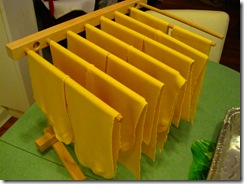My wife does not enjoy traditional blintzes. She finds the texture to be less than desirable. I think she disapproves of Farmer’s Cheese, the traditional filling, so I made a substitution of ricotta cheese. The end result is a somewhat creamier filling, but also a tad more runny. It’s still delicious, and it won’t stop me from making them over and over.
First step is making the crêpe batter. This can be done the evening before and allowed to sit overnight; it makes for a more tender crêpe.
Dump the batter ingredients in a blender and mix well. Make sure to stop once or twice to scrape down the sides.
Put the batter in a cup overnight. You could let it sit for an hour, but I prefer this because it’s easier in the morning. The next day just give it a quick stir and you’re ready to go.
All great foods start with butter.
Spoon about a 1/4 cup of batter and swirl it around until the pan is coated. When the edges are golden and the center looks “dry” you are ready to flip. The bottom should look lacy and browned.
About 30-45 seconds on the other side should be long enough. You just want to brown both sides. Repeat until all batter is gone and you have a stack of crêpes.
On a side note, one day I’m going to make a Crêpe Cake (also called Mille Crêpe even though it doesn’t use 1,000 crêpes but only 20).
(See the 2005 NY Times article The Way We Eat: Building a Modern, Multistoried Dessert By AMANDA HESSER for more details on the Mille Crêpe.)
Back to blintzes!!!
Ricotta cheese, cream cheese and sugar. Any questions?
You can add an egg or yolk if you want a richer (and firmer) filling, but I opted out. Also I added vanilla. I like the way my blintzes turned out and I’m not changing now.
(You didn’t put the butter away yet, did you?)
Heat them on medium heat with a bit of butter. The crêpes should get hard and crispy. Carefully turn them until they are crispy all the way around. The filling should be very hot at this point.
Serve with more sugar and a dollop of sour cream.
(Putting two on a plate makes it seem like I care about serving size, but truthfully, there are never leftovers.)
Have a great breakfast!
Basic Crepe Recipe
4 eggs
1 cup flour
1/2 cup milk
1/2 cup water
1/2 teaspoon salt
2 tablespoons melted butter
Measure all ingredients in to blender jar; blend for 30 seconds. Scrape down sides. Blend for 15 seconds more. Cover and let sit for 1 hour. (This helps the flour absorb more of the liquids.) Makes 12-14 crepes.
Blintz Cheese Filling
4 ounces softened cream cheese
1 1/2 cups of ricotta cheese
1 egg (optional)
3 tbsp powdered sugar (use granulated if it's all you have, but then let it sit for a while to let the sugar dissolve.)
Make the Crêpes
Pour 1/4 cup batter into a hot buttered 8” pan. Swirl the pan to coat. When the edges are brown and the center looks “dry”, flip the crêpe and cook for another 30-45 seconds. Repeat until all the batter is used.
Make the Blintzes
Put about a tablespoon of filling on the crêpe and make a burrito. Repeat until all the crêpes or all the filling is gone. Then fry the blintzes in a pan with a bit of butter until the outside is crispy and the center is hot. Serve with granulated sugar, sour cream or fruit preserves.

.jpg)
.jpg)
.jpg)
.jpg)
.jpg)
.jpg)
.jpg)
.jpg)
.jpg)
.jpg)
.jpg)
.jpg)
.jpg)
.jpg)
.jpg)
.jpg)
.jpg)











